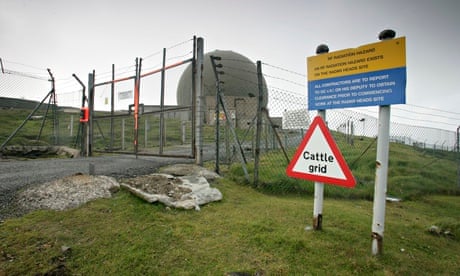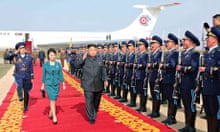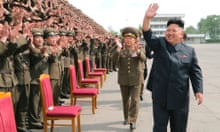The UK government drew up a top secret list of 106 cities, towns and bases across the country seen as "probable nuclear targets" in the early 1970s, according to documents released by the National Archives.
During the cold war, a list of the places thought likely to come under nuclear attack by the Soviet Union was agreed by military commanders, the intelligence services and the Cabinet Office under Conservative prime minister Edward Heath.
Although most major cities were included, there were some notable omissions. Cambridge was on the target list but not Oxford; Bristol but not Brighton; and Edinburgh but not Aberdeen.
The list of "probable nuclear targets in the United Kingdom", approved by the Cabinet Office, was circulated to defence chiefs marked "top secret" by Air Commodore Brian Stanbridge on 2 May 1972. "It is not a comprehensive list of all targets likely to be attacked in the event of general war," he wrote. It included 38 towns, cities and centres of government, 37 UK and US air bases, 25 control, communications and radar facilities and six naval sites.
An annex to his memo quoted an estimate from the joint intelligence committee that the Soviet Union could launch an initial nuclear strike against Britain with 150 land-based missiles, plus an unknown number of submarine-launched missiles. "They are unlikely to be inhibited by the question of overkill," it warned.
Estimates of Soviet nuclear strikes used "similar planning assumptions to those which we ourselves might use," the annex stated. "Thus, it is likely that the enemy would aim to achieve a minimum of 50% damage expectancy with a 90% or more assurance factor."
London was expected to be devastated by two to four bombs of up to five megatons each exploding over the city. Glasgow, Birmingham and Manchester were each said to be in line for one or two "airbursts" of up to five megatons. That's 333 times more powerful than the 15-kiloton US nuclear bomb that flattened the Japanese city of Hiroshima in August 1945, killing 140,000 people.
There were disputes about some of the estimates, with one memo pointing out that Home Office scientific advisers "find it difficult to see why an enemy would wish to deliver a three-megaton attack on Swansea and on Leicester when, in their view, one megaton on each target would be sufficient to cause almost complete destruction of those cities."
According to military planners, some of Britain's remoter regions could also be blasted. A radar station at Saxa Vord, now a holiday resort on the UK's most northerly populated island of Unst in Shetland, was down to be hit by a three-megaton bomb.
Another target was Orford Ness on the Suffolk coast, which was involved in an experimental US radar system known as Cobra Mist and is now a nature reserve. Nuclear submarine bases on the Clyde near Glasgow were on the list, along with nuclear airfields like those at Greenham Common in Berkshire and Machrihanish on the Mull of Kintyre.
Other high-level memos from 1971 said that the target list was drawn up for military planning purposes and to help "contingency planning particularly in the field of home defence". Home defence meant protect and survive measures such as shelters to help civilians under nuclear attack.
But according to the researcher who found the documents, former nuclear weapons design engineer Brian Burnell, the real aim was not to defend civilian targets. Military planners wanted to try to ensure that UK-based nuclear bombers survived to launch a counter-attack against the Soviet Union, he said.
He argues that the Whitehall planners were confused about Soviet military intentions. "I'm baffled by the omission of targets like power plants, or other major infrastructure."
A nuclear historian from Aberystwyth University, Kristan Stoddart, said Britain was a priority target for the Soviet Union in the 1970s because it was the only state in western Europe that was part of Nato's military structure. France had left in 1966. He said: "For a country the size of Britain there was no civil defence against large-scale nuclear attack – anything else was a myth. Whitehall knew this and most of the population knew it."
A spokeswoman for the Ministry of Defence said: "These are historical records and like many other documents released every year by the National Archives have little or no relevance to the present day."







Comments (…)
Sign in or create your Guardian account to join the discussion